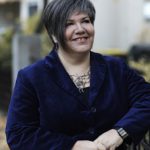Overview
Panel Discussions
- Polish Jewish Women in Leadership Positions: Then and Now – Anna Azari (Israel/Poland), Anna Chipczyńska (Warsaw, Poland), Agnieszka Graff (Warsaw, Poland), Kazimiera Szczuka (Warsaw, Poland), Bożena Keff, feminist and writer (Warsaw, Poland), moderator: Anna Makówka-Kwapisiewicz (Cracow, Poland), moderator: Anna Makówka-Kwapisiewicz (Cracow, Poland)
- Jewish Revival in Poland: Personal narratives from Danielle Chaimovitz, Bente Kahan, Piotr Kwapisiewicz, Marcin Wodziński, moderator: Edyta Gawron
Women from Breslau
- Unknown and forgotten women. Traces of rabbis wives in Breslau – Agata Rybińska (Lublin, Poland)
- Double Forgotten – Jewish Women Artists from Breslau – Małgorzata Stolarska-Fronia (Toruń, Poland)
- Karla Wolff – Eleonore Lappin-Eppel (Vienna, Austria)
- Edith Stein – Rabbi James Baaden (London, UK)
- Rosa Luxemburg Behind Bars in Breslau: a collage reading – Sandi Wisenberg (Chicago, USA)
Jewish Women in Arts
- Series of paintings – collages about Jewish women artists from Poland – Zuza Ziółkowska Hercberg (Warsaw, Poland)
- Texts as Found Objects – Marion Kahnemann (Dresden, Germany)
- Personal Affects – Going into the Archive – Tanya Ury (Cologne, Germany)
- „Schoraschim“ /roots – transgenerational resources and there working up in Arts: exhibition and artist talk – Ruth Herzka Bollinger (Basle, Switzerland) (moderation: Esther Rietschi-Berns)
- Female Jewish Artists in Yugoslavia in the interwar Period – Martina Bitunjac
- “With Yiddish Song on her Lips…“ – Dina Blumenfeld – Anna Rozenfeld (Poland)
- „Zuzanna Ginczanka. Fire- Bird“ – conversations about the reappearance of unexpected memories and forgotten female artists – Gabi von Seltmann
Women in Politics
- Female Face of the “Jewish Revival in Poland”: Biographies of Polish-born Jewish Activists in Newly Democratic Poland after 1988 – Aleksandra Wilczura (Wroclaw, Poland)
- Tikkun HaOlam as a Political Attitude: Philosophical Grounds for Feminist Change – Hannah Peaceman (Erfurt, Germany)
- Jewish Response to the “Double Genocide” Discourse – Tania Reytan-Marincheshka (Sofia, Bulgaria)
- „Mowa ta wywarła potężne wrażenia“ (This speech had made a good impression) – Róża Pomeranc-Melcer (1880-1934): Feminist, Zionist and Politician – Angelique Leszczawski-Schwerk (Dresden, Germany)
Feminist Text Studies
- Shirat HaYam – the song of the Sea – Jalda Rebling (Berlin, Germany)
-
God-less Torah Study: Finding Ourselves in the Biblical Text – Ulrike Offenberg
New Roles and Spaces for Women in Judaism
- Josefa Metz and Meta Samson: Two ‘New Jewish Women’ in Nazi Germany – Hadassah Stichnothe (Hanover, Germany)
- “The Woman in the House of God” Revisited – Hartmut Bomhoff (Berlin, Germany)
- Cantor + Woman = Feminist? – Mimi Sheffer (Berlin, Germany)
Religious Feminism
- Post-Holocaust Jewish Feminist Theology and its Optics: Dialogue with Melissa Raphael’s The Female Face of God in Auschwitz – Katarzyna Liszka (Wroclaw, Poland)
- Contestation and Opportunity: An Analysis of Two New Orthodox Jewish Women’s Communal Rituals – Lindsey Taylor-Guthartz (London, UK)
- On the Liturgical Periphery: Music, Gender, Power, and Cross-Cultural Negotiations in Women’s Rosh Chodesh Services – Miranda Crowdus (Hanover, Germany)
- Inter-religious Dialogue on Marriage and Divorce – Sharon Shenhav
Jewish Survival – Jewish Revival
- Jewish Women Growing up under Communist Rule: Roundtable – Lara Dämmig, Marion Kahnemann, Tania Reytan
- The Jewish Romanian Women: Post Communism/Revolution Times – Peninah Zilberman (Canada/Israel/Romania)
- Post war alternatives for Jewish women from Maramures – Alina Marincean (Maramures, Romania)
- We Will Survive: Jewish History of Moldova in Images, Maps, and Pictures – Irina Shihova (Kishinev, Moldova)
Saving the Past – Preparing the Future
- The Future of the Past: A look at the first two decades of The Jewish Women’s
Archive – Gail Twersky Reimer (MA, USA) - Potraits and memories of the Jewish community in Serbia: Women then and now – Dragana Stojanovics, Sonja Viličić (Belgrade, Serbia)
Sports & Dance
- The female muscle-jew: The gender-transgressing potential ofJewish Sports Associations – Sarah Egger (Vienna, Austria)
- Judith Berg and the Language of Dance – Gail Twersky Reimer (MA, USA)
Workshops
- Jewish cut-out workshop + lecture – Monika Krajewska:
- Master Class: open klezmer music workshop – Alicia Svigals (USA)
Please reserve your spot at alternatives@fbk.org.pl - Biolog Workshop – Ewa Alfred:
- Mentoring – Mariann Ziss (Prague, Czechia)
- “Bye, bye, Cancer! Welcome, Life!” How a life threatening diagnosis helped me to become a better Jew and a stronger feminist – Gunda Trepp (San Francisco, Berlin)
Book Presentations
- Bet Debora Journal Engendering Jewish Politics – Eleonore Lappin-Eppel (Vienna, Austria), Lara Dämmig (Berlin, Germany)
- Kol Isha: The Voice of Women Rabbis in Contemporary Jewish Life (Women Rabbis in the Pulpit: A collection of Sermons) – Rabbi Barbara Borts (UK)
Exhibitions Performances
- Songs about Women: Concert – Bente Kahan
- Jewish Women: A World of Tradition & Change – Joan Roth
-
“Nudity empowers some, modesty others” – Ania Ciszewska aka Betty Q burlesque
- Miracle in Cracow (2004) – Diana Groó (Budapest, Hungary)
- Yellow Ticket – Alicia Svigals, Marilyn Lerner (USA)
- Happy Hippie Jewbus – Anna Adam (Berlin, Germany)
- Anna and Jalda: Movie screening – Anna Adam, Jalda Rebling
Tours
- The Jewish Women of Breslau/Wrocław: city walk with Anna Nienartowicz, Jewish Studies Department, University of Wrocław and special guest Sandi Wisenberg, who will read excerpts from Rosa Luxemburg ’s writings in front of the prison
-
The Historic Jewish Cemetery Tour with Renata Wiłkoszewska-Krakowska,director of the Museum of Cemetery Art
********
Polish Jewish Women in Leadership Positions: Then and Now – Panel Discussion
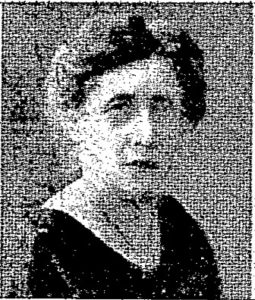 Inspired by Róża Melcer, political and social activist in inter-war Poland, the only Jewish woman to be elected to the Polish parliament and leading member of WIZO, the panel will discuss issues facing Jewish women in Europe then and now.
Inspired by Róża Melcer, political and social activist in inter-war Poland, the only Jewish woman to be elected to the Polish parliament and leading member of WIZO, the panel will discuss issues facing Jewish women in Europe then and now.
panelists:
- Anna Azari, Israeli ambassador in Poland
- Anna Chipczyńska, head of the Jewish Religious Community in Warsaw (first woman and first person below forty to be head of the largest Jewish community in Poland)
- Agnieszka Graff, writer, Warsaw
- Kazimiera Szczuka, literary critic, TV presenter, politician, Warsaw
- Bożena Keff, feminist and writer (Warsaw, Poland)
- moderator: Anna Makówka-Kwapisiewicz, president of the Jewish Association Czulent, Kraków
The Panel is sponsored by the Rosa Luxemburg Foundation
Happy Hippie Jewbus – Anna Adam (Berlin, Germany)
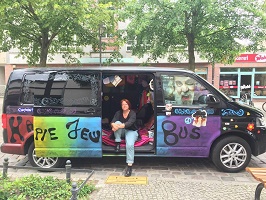 Anna Adam – Artist, Jew, Berliner Anna Adam studied in Düsseldorf and Hannover. Her art is being shown in numerous European museums and galleries. Her satirical exhibition „FEINKOST ADAM©“ 2002 in the Jewish Museum of Fürth incited an international controversy. Her latest project the Happy Hippie Jew Bus, is a colorful rolling classroom teaching about Jewish life. The bus can be found on marketplaces, universities, schools. The project exposes and overcomes cliches of Jews and Jewish life in a playful and creative manner. Anna Adam lives and works in Berlin
Anna Adam – Artist, Jew, Berliner Anna Adam studied in Düsseldorf and Hannover. Her art is being shown in numerous European museums and galleries. Her satirical exhibition „FEINKOST ADAM©“ 2002 in the Jewish Museum of Fürth incited an international controversy. Her latest project the Happy Hippie Jew Bus, is a colorful rolling classroom teaching about Jewish life. The bus can be found on marketplaces, universities, schools. The project exposes and overcomes cliches of Jews and Jewish life in a playful and creative manner. Anna Adam lives and works in Berlin
A selection of her exhibitions: Jewish Museum Berlin, Jewish Museum Franken/Fürth, Jewish Museum Hohenems/Austria, Jewish Museum Dorsten, Ethnological Museum Berlin, Technical Museum Berlin, Museum Bochum, City galery of Kiel, Israel Galery Linka Amsterdam, City Galery of Suhl, Palazzo Gheraldesca Livorno, Historical Museum Bielefeld, Galery SOTODO Toronto, Womens Synagogue Worms, Schloss Dachau, Palais am Festungsgraben Berlin, Cardial Point London, Kolo and Galery Eiswürfel Berlin/Frankfurt/NY/Paris/Tokyo
Female Jewish Artists in Yugoslavia in the interwar Period – Martina Bitunjac
The lecture deals with the biographies and works of female Jewish artists in the Kingdom of Yugoslavia from 1918-1941. Ashkenazi and Sephardic Jewry had not only influenced the various local Jewish communities in the Kingdom of Serbs, Croats and Slovenes, called the Kingdom of Yugoslavia since 1929, but also the social, economic and cultural development of the southern Slavic country. Jewish painters, architects, musicians and actors made outstanding contributions to the cultural scene. Many female Jewish artists such as the dancer Riki Levi, the theater actress Lea Deutsch or the photographer Elvira Kohn were at the peak of their career in the interwar period, which came to an abrupt end with the dismantling of the multinational state. This is one of the reasons why it is difficult to reconstruct their lives today.
“The Woman in the House of God” Revisited – Hartmut Bomhoff (Berlin, Germany)
“I can claim that women have gained themselves their right to vote in community
elections, and that we have achieved this through peaceful means,” wrote Bianka
Hamburger (1877‒1942) in 1926. Hamburger, the first female member of the Board
of Representatives of the Jewish Community of Berlin, was one of the ten
participants of a symposium entitled “Die Frau im Gotteshaus”, (“The Woman in the
House of God)” which was hosted by the Vereinigung für das liberale Judentum in
Deutschlands (Association for Liberal Judaism in Germany) in fall 1926, two years
after Regina Jonas had enrolled herself at the Hochschule für die Wissenschaft des
Judentums. It is widely assumed that Jonas pursued her rabbinical ordination in
1935 on her own accord, with the British Reform leader Lily Montagu, who in 1928
delivered the first sermon ever given by a woman from the pulpit of a German
synagogue, being a catalyst to enhance women’s participation inside the sanctuary.
A close reading of the proceedings of the 1926 symposium, however, gives us the
opportunity to put the story of Regina Jonas in a wider context.
Apparently in response to the development in the German Protestant Church, in
which women became candidates for preaching positions in 1925, more and more
Jewish lay leaders discussed not only the role of women in community and
synagogue governance but also of women in the rabbinate: Of the seven women
who had a say in the symposium, four especially raised the possibility of women
rabbis. In my presentation, I will introduce the ten agents of change who contributed
to the symposium and discuss their approach to issues of leadership and authority as
well as their impact on creating alternatives for Jewish women in Weimar Germany
and beyond. I will be happy to put an emphasis on the educator and local politician
Paula Ollendorf (1884‒1938), whose achievements are so closely connected with
Breslau, and the rabbi of the liberal synagogue of Breslau, Rabbi Dr. Hermann
Vogelstein (1870‒1942).
Hartmut Bomhoff M.A. serves as Communications Officer of the Abraham Geiger
College as well as a Research Assistant at the School of Jewish Theology at the
University of Potsdam. He is the editor-in-chief of the Jewish Voice from Germany. In
2015 he authored together with Rabbi Andreas Nachama and Rabbi Walter Homolka
an introduction into Judaism, Basiswissen Judentum, and organized an international
conference to mark the 80th anniversary of the ordination of Rabbi Regina Jonas,
“The Role of Women’s Leadership in Faith Communities.”
Kol Isha: The Voice of Women Rabbis in Contemporary Jewish Life (Women Rabbis in the Pulpit: A collection of Sermons) – Rabbi Barbara Borts (UK)
Last year at the Bet Deborah Conference, I was challenged to publish a collection of my sermons. But, as it was the year of the 80th anniversary of the ordination of Regina Jonas, and the 40th anniversary of the ordination of Jacky Tabick, first women rabbi in the UK, I decided to ask all women to participate in publishing our sermons and asked my colleague Elizabeth Tikvah Sara to co-edit this book with me. In speaking about the collection at various conferences and synagogues, I have had the opportunity to reflect on what Jewish life is like since the voices of women have been added to the chorus, and what issues still confront us.
On the Liturgical Periphery: Music, Gender, Power, and Cross-Cultural Negotiations in Women’s Rosh Chodesh Services – Miranda Crowdus (Hanover, Germany)
My paperwillexplore the possibilities for musical participation in women’s Rosh Chodesh (New Month) services and partnership minyanim, both in Europe and internationally, in orthodox Jewish contexts. This phenomenon remains relatively unexplored by academic scholarship perhaps due to a normative focus on reformed/liberal movements and due to the diversity of the women’s groups being eclipsed by an emphasis on gender inequality, rather than on the nuances of the musical liturgy. However, current communities of religious Jewish women’s musical practice are loci of major intercultural-musical exchanges, significantly influencing the musical and religious experience of individuals. My paper will critically examine how orthodox Jewish women negotiate communal identity on the periphery of the traditional orthodoxy, suggesting new ways to build fields of critical interdisciplinary scholarship on Jewish women and the arts, characterized by the complexity of contact and practice.
Miranda Crowdus is an ethnomusicologist and writer residing in Hanover, Germany. She recently completed her PhD at City University London, which focused on musical practices in the complex urban environment of South Tel Aviv, Israel. She is currently a Research Associate at the European Centre for Jewish Music at the Hanover University of Music, Drama and Media, working on original research and expanding the new MA programme in Jewish Music Studies.
The female muscle-jew: The gender-transgressing potential ofJewish Sports Associations – Sarah Egger (Vienna, Austria)
Sarah Egger BTh, C.E.O. oft he Coordinating Committee of Jewish-Christian Cooperation in Austria, Born 1992 in Vienna, June 2010: High School Exams, Working at the Equality, Diversity, and Inclusion Conference 2010, 2010-2015: Studying Protestant Theology at the University of Vienna, 2012: Study Assistant at the Institute for New Testament Studies, 2012-2015: Organizing the lecture series AGORA of the Forum for World Religions, 2013-2014: Office Assistant at the Forum for World Religions, 2014-2015: Organizing the lecture- and discussion series „Homosexuality and Christian Faith“ at the University of Vienna, 2014-2015: Study Assistant at the Institute for the Science of Religions, January 2015: Finished study as Bachelor of Theology, Since then: Gender Studies (Master) at the University of Vienna, Since September 2015 C.E.O. of theCoordinating Committee of Jewish-Christian Cooperation in Austria
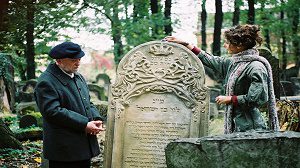 Miracle in Cracow (2004) – Diana Groó (Budapest, Hungary)
Miracle in Cracow (2004) – Diana Groó (Budapest, Hungary)
The debut film of Diana Groó co-produced with Poland in 2004(in English, Hungarian, Polish, and Yiddish, with English subtitles) follows a young Budapest Jew named Piotr (Maciej Adamczyk) who has become obsessed with a book of magic his grandmother tried to hide from the Nazis. He traces it to Krakow, where a young woman named Eszter (Eszter Bíró) is using it at the grave of a rabbi. Piotr steals the book, but his feelings about Eszter begin to complicate his plans. The film beautifully depicts the old Jewish quarter of Krakow.
Diana Groó, filmdirector, received her education in Budapest, obtaining a Bachelor’s degree inFrench-Hebrew from the Faculty of Arts, ELTE, followed by a Master’s in TV and Film Directing, at the Department of Film and Television Directing at the Hungarian Film Academyin 2000. Co-founder of Katapult film studio (2002) and Duna Dock (2013).
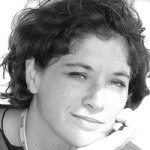 After her prize winning shorts and documentaries, her debut feature film was A Miracle in Cracow, a Central European Jewish magic tale, in Polish-Hungarian coproduction in 2004. Her documentary What lies ahead about disabled children of the Hungarian Pető Institute, was awarded by the Jury of Verzio 4 Int. Human Rights Doc. Filmfestival in 2005. Her second feature film Vespa (2010) /a roadmovie of a Romani teenager/, awarded by Unicef and the Dialog Prize for Intercultural Communication in Cottbus, got the Best Director’s award in Geneva and Los Angeles. Her “Wild Imagination” art-history series, presenting the art of Marc Chagall, August Renoir, Pieter Bruegel and Henri Rousseau opened the contemporary art exhibition of Herzlya Muzeum in Israel in 2005. The “Intervisual Media program between Painting&Cinema” at Haifa University, involved the series into its courses along with the works of Peter Greenaway, Derek Jarman and others.
After her prize winning shorts and documentaries, her debut feature film was A Miracle in Cracow, a Central European Jewish magic tale, in Polish-Hungarian coproduction in 2004. Her documentary What lies ahead about disabled children of the Hungarian Pető Institute, was awarded by the Jury of Verzio 4 Int. Human Rights Doc. Filmfestival in 2005. Her second feature film Vespa (2010) /a roadmovie of a Romani teenager/, awarded by Unicef and the Dialog Prize for Intercultural Communication in Cottbus, got the Best Director’s award in Geneva and Los Angeles. Her “Wild Imagination” art-history series, presenting the art of Marc Chagall, August Renoir, Pieter Bruegel and Henri Rousseau opened the contemporary art exhibition of Herzlya Muzeum in Israel in 2005. The “Intervisual Media program between Painting&Cinema” at Haifa University, involved the series into its courses along with the works of Peter Greenaway, Derek Jarman and others.
In 2008 Diana premiered first time in Hungary the stage adaptation of Katherine Kressman Taylor’s prophetic novel about the Nazism “Address Unknown”, that she staged also in Sao Paulo Theatro Hebraicain 2011. Her last work is “Regina” (2013) a poetic documentary about the world’s first woman rabbi was the winner of the Lia Award for dealing with Jewish Heritage at 30th Jerusalem Film Festival 2013 . (Other awards: Phoenix Award of Warsaw Jewish Motifs Filmfestival, Jury Award of Moscow Jewish Film Festival, Hungarian Film Critic’s Award, screenings in Unesco Palais, Library of Congress, Yad Vashem)
Contestation and Opportunity: An Analysis of Two New Orthodox Jewish Women’s Communal Rituals – Lindsey Taylor-Guthartz (London, UK)
When is religious innovation welcomed and when is it opposed? The paper examines two new communal women’s rituals currently practised in north-west London, comparing and contrasting them in order to analyse the complex interaction of creativity and constraint that they embody. The first is a women’s tefilah (prayer) group held in Stanmore, which, though following the standard order of sabbath prayers, aroused heated controversy and was excluded from the local synagogue for eighteen years; the second is a women’s berakhah (blessing) party held in Hendon, which, though totally innovative in structure and understood in thaumaturgic terms by some participants, takes place in a synagogue with rabbinic approval and participation. A critique of both secular feminist and Jewish apologetic thinking about the role of Orthodox Jewish women leads to a more nuanced understanding of women’s agency and self-empowerment within the constraints of male-controlled institutions and power relations. Contestations of the control and use of sacred space (synagogues), sacred time (sabbath versus Rosh Hodesh [new moon]), and sacred activity (traditional prayer services versus an innovative use of berakhot [blessings]) are seen to determine the contrasting reactions to the two rituals: the women’s tefilah group is viewed as a threat to male control of these areas and is thus subject to restriction, while the berakhah party is regarded as only tenuously linked to these sacred areas, and is not controversial. Both rituals provide a space where women’s voices are heard, in contrast to most ritual arenas in the Orthodox world. The participants understand these rituals either as offering an opportunity for heightened spirituality or as a powerful means of fulfilling women’s functions of protecting, nurturing, and healing their families and communities.
Dr Lindsey Taylor-Guthartz, London School of Jewish Studies
„Schoraschim“ /roots – transgenerational resources and there working up in Arts: exhibition and artist talk – Ruth Herzka Bollinger (moderation: Esther Rietschi-Berns)
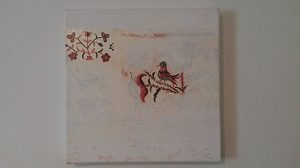 It’s a phenomena that a generation is handing over her imaginations, behaviors and even materialistic values by nonverbal messages through things/objects. Inspired by textiles from the East (Czechoslovakia, Hungary, Poland, Rumania) is Ruth Herzka working in her paintings about their motives, patterns, colours and at last but not least their transfer of a specific and not exchangable atmosphere. She is working on canvas and textiles in mixed media. As she has her familiar roots in above countries, she is by her artistic aproach working on their impact on herself and her family – in the sense of resources.
It’s a phenomena that a generation is handing over her imaginations, behaviors and even materialistic values by nonverbal messages through things/objects. Inspired by textiles from the East (Czechoslovakia, Hungary, Poland, Rumania) is Ruth Herzka working in her paintings about their motives, patterns, colours and at last but not least their transfer of a specific and not exchangable atmosphere. She is working on canvas and textiles in mixed media. As she has her familiar roots in above countries, she is by her artistic aproach working on their impact on herself and her family – in the sense of resources.
Ruth Herzka Bollinger, Artist and Psychotherapist, studied Arts, Psychology, Anthropology and Psychotherapy in Arts in Zurich, Haifa (IL) and Basle. She is working and living with her family in Basle, Switzerland.
back to the top
Texts as Found Objects – Marion Kahnemann (Dresden, Germany)
Marion Kahnemann works to a great extent with found materials made by humans and marked by human use, each with its own history, thrown away by people. She returns them to a human context, although a different one. Besides this she explores the possibilities of the interaction between the visual and the textual. The treatment of texts is part of a longer process, in which she brings together her findings – these might be found objects, found texts, stories, daily experiences, encounters, miss meetings or just visual discoveries during the process of making. It’s a kind of dia-, tria- or tetralogue – a talk between the different materials, the colors forms, texts, subtexts, herself, the viewer etc. Her aim is not at all to illustrate the texts!
Marion Kahnemann (born 1960) lives and works as a sculptor in Dresden, where she attended art college and was awarded the city’s art promotion prize in 1993. Since 1998, she has taken part in numerous exhibitions in Germany and abroad, including ones in Dresden, Berlin, Sofia, Erfurt, Suhl, Chemnitz, St.Petersburg, Wroclaw, Kiev, Basel, Uppsala, Oakland-California and Madison-Wisconsin.
Marion Kahnemann was a student at Paideia, the European Institute for Jewish Studies, in Stockholm in 2000-2001, a period that gave her much inspiration for her practice. Several of her works are situated in public spaces: she constructed a fountain for the Elsa-Fenske-Home for the Elderly in 1998 in Dresden; designed a wall at Beit haGalgalim, an institution for handicapped people in 2000 Herzliya-Israel, and at Paideia 2002. She created a memorial for the deportation of Dresden’s Jews in 2001 at Neustadt-train station in Dresden, and three “Denk-Orte” (memorial places of reflection) in 2007-2009 which confront the gradual systematic exclusion of the Jews that took place in the city from the 1930s onwards. www.mkahnemann.de
„Mowa ta wywarła potężne wrażenia“ (This speech had made a good impression) – Róża Pomeranc-Melcer (1880-1934): Feminist, Zionist and Politician – Angelique Leszczawski-Schwerk (Dresden, Germany)
Róża Pomeranc-Melcer was an active and vigorous Zionist and one of the few women elected to the Polish Sejm (parliament) in 1922 and the first Jewish female MP. She advocated women’s policy within Zionism and women’s rights. Her acticity was strongly linked with Galicia, in the 19th Century part of the Austro-Hungarian Empire, where she was born and dedicated herself to female and youth empowerment, social projects and projects related to educational policy. Melcers name stands for agitation and agency in „women’s spaces“ in Zionism, i.e. she initiated and led the the women‘ s organizations KKŻ (Organization of Jewish Women) in Lemberg/Lwów and the WIZO (Assembly of Jewish Women) in Lower Poland. In my paper, I will focus first Melcers involvement in women’s organization on the example of the city of Lwów and secondly her involvement in politics as MP. Thus, I will try to highlight both, on the one hand her point of view which role Jewish women should have in the dimension of Zionism and on the other her viewpoint as a Jew and woman in the Polish state of the interwar period.
Angelique Leszczawski-Schwerk, historian, slavicist, specialized journalist. She obtained her PhD at the Institute for East-European History at the University of Vienna. She currently works at the Institute for History (Modern and Recent History) at the Technical University of Dresden. Research interest: women’s movements in 19th and 20th century in Eastern Europe, Polish-Jewish history, social history. Publications (among others): Die umkämpften Tore zur Gleichberechtigung – Frauenbewegungen in Galizien (1867-1918) [The Embattled Gates to Equality – Women´s Movements in Galicia], Wien et al. 2014.
Post-Holocaust Jewish Feminist Theology and its Optics: Dialogue with Melissa Raphael’s The Female Face of God in Auschwitz – Katarzyna Liszka (Wroclaw, Poland)
My presentation is devoted to the monograph by Melissa Raphael The Female Face of God in Auschwitz. Jewish Feminist Theology of the Holocaust.The author presents a groundbreaking discussion with classical works in the field ofJewish post-Holocaust theology as well as the original conception of the Jewish feminist theological thought.I will analyze it from the broader perspective of the question: what does gender studies and feminist theory contribute to the understanding of the Shoah? How does Melissa Raphael define the fundamentals of feminist theology of the Shoah? If, as I believe, The Female Face of God in Auschwitz provides the new optics to read and re-read the voices of the Shoahwitnesses, artists, and scholars – what optics would it be?
Dr Katarzyna Liszka – graduated from philosophy and cultural studies, has received PhD with a dissertation on philosophical and ethical responses to the Shoah. She in an Associated Professor at the Department of Jewish Studies (the University of Wroclaw, Poland). Her special fields of interest are the Shoah studies, as well as contemporary philosophy and ethics. She is the author of numerous articles, translations, and co-editor of four books, among others: Beauty, Responsibility, and Power (2014) and Międzyrozumieniem a porozumieniem (Between Understanding and Agreement, 2015). She teaches courses on: the Shoah, Jewish philosophy, Jewish ethnography and museums.
Post war alternatives for Jewish women from Maramures – Alina Marincean (Maramures, Romania)
The perspectives of Jewish women in post war Europe are directly influence by the tragic experience of the war and its implications towards their families. Prewar roles and responsibilities of Jewish women from Maramures were established by gender specific roles. The experience of the war and holocaust opened up new perspectives for European Jewish Women based on this most relevant experience of their life.
Deported women from Maramures that came back and remained were using the alternative to fill in and fit in with no major impact on the community life. The limitation of their development was in direct connection with the geographical isolation, social, political and economic life of the country as being one of the most communist countries in Eastern Europe. On the contrary women that decided to leave Maramures after the end of the war did get involved in different activities that concerned war experiences, holocaust education besides creating career.
Some examples will project a pattern: Dora Apsan Sorell doctor and writer (Letters to Miriam), Rothbart Hindi – writer (The girl from Sighet, a memoir), Gisella Perl doctor and writer (I was a doctor in Auschwitz) Alice Koppel – writer (Tapestry of hope), Bilbool Rose – scientist she wrote an autobiographical novel (Personally speaking: deeds recounted from Sighet to Jerusalem) and last but not least our most relevant example Hedi Fried which will be the focal point of the contribution to the conference.
Author and psychologist, Holocaust survivor she was awarded with the Illis Quorum Gold medal and she was declared the European of the Year in 1997. She was the first European psychologist to have been created special therapy groups for Holocaust survivors in what is now the famous the Café84 in Stockholm.
Alina Marincean: Curator, Jewish Cultural Museum. Elie Wiesel memorial House, Sighetu Marmatiei, Maramures (Romania)
Tikkun HaOlam as a Political Attitude: Philosophical Grounds for Feminist Change – Hannah Peaceman (Erfurt, Germany)
This presentation suggests an understanding of TikkunHaOlam as a political attitude from a philosophical point of view. First, it gives a sketch of the meaning of TikkunHaOlam as a political concept and active attitude towards society. Second, it reflects the normative dimensions of the concept with focus on Jewish feminist claims. What does changing the world mean from a Jewish feminist perspective? What are strategies that constitute the political attitude of changing the world and enable women to engage actively with societal relations? The aim is to provide a conceptual framework and philosophical grounds for creating alternatives for Jewish women in Europe. The claim is that creating alternatives for Jewish women in Europe implicates transforming society in a way that it becomes a better world for every person by raising awareness for unheard voices and engaging in active discussion about how people want to live together.
Hannah Peaceman (born 1991), holds an MSc in Philosophy of the Social Sciences (LSE 2014) and an M.A. in Philosophy (FSU Jena 2016).Her research interests lie in the field of political philosophy, feminist philosophy and Jewish philosophy. Currently she is working on her PhD at the Max-Weber-Kolleg in Erfurt. The topic of her PhD is “Jewish political philosophy in the 19th century and until the Shoah in the German-speaking diaspora”.
Shirat HaYam – the song of the Sea – Jalda Rebling (Berlin, Germany)
Shemot 15:1-18 is also known as the song of Moses. But was it really Moses who sang it? What about Shemot 15:20-21 Miriam and the women with the trimbels? Prof. Nissim Amzallag (Ph.D.) is a researcher in plant physiology, who has worked at the Hebrew University of Jerusalem as well as the Judea Center for Research and Development. But he also did research on the structures of T´hilim – the psalms. Shirat Hayam (Song at the Red Sea) has been written as an ancient system of chant. Dr Nissim Amzallag and Michal Avriel (Ben Gurion University) have uncovered a fascinating, ancient form of responsive singing. Chazan Jaclyn Chernett (EAJL London) created a practical version of his theory. Let us experience this amazing version of the ancient text. Lets sing it together. There is no need for high musical education but an open ear and an open heart. This workshop will give you a taste of the amazing energy of an ancient text.
Chazan Jalda Rebling works with christian and muslim women singing T´hillim – Psalms in the old way of call and response, following the structure of the ancient poetry. Nussach, mode and maqam, modal music we use in many cultures, brings us together. The languages make the difference. www.jalda-rebling.com
The Future of the Past: A look at the first two decades of The Jewish Women’s Archive – Gail Twersky Reimer
In 1995, as the 20th century was drawing to a close, the visionary founders of the
Jewish Women’s Archive set out to make certain that another century of Jewish
women’s lives, thoughts and achievements would not be lost to history. Though
widespread use of the internet was only just beginning, the founders, for whom
access to the documents, stories and information was paramount, pioneered the
creation of an online archive, one of the first of its kind.
While the medium through which it accomplishes its mission no longer marks JWA
as unique, JWA continues to be the only organization in America solely dedicated to
uncovering, chronicling and making known the stories of Jewish women. As one
user wrote, “No other organization is compiling now what will in future be the
history of Jewish women, and nowhere else is there this rich treasure trove of
information about Jewish women up till now – to explore, dip into, or immerse
oneself in, depending on the need or the mood.”
In this presentation the founding director of the Jewish Women’s Archive will
present a brief history of JWA , focusing on the challenges and opportunities that
defined its initial direction, as well as the pivots made during its second decade.
She hopes to explore with her audience options for increasing the available
documentation and information on Jewish women across Europe.
Judith Berg and the Language of Dance – Gail Twersky Reimer
Judith Berg, a Warsaw born dancer who trained with Mary Wigman, is best known
for her choreography and performance in the last important yiddish film to be
produced in Warsaw, The Dybbuk (1937.) Less well known is her work in Breslau,
where she established a dance school in the years following the war, and her work
in Otwock in the first Jewish orphanage to be established after the Shoah – in March
1945.
The children, many of whom had been hidden in convents, monasteries or by
Christian homes, arrived at the orphanage confused about who they were. Often
traumatized by the murder of Jews that they had witnessed; grieving for family they
had lost, or under the influence of anti-Jewish prejudices they were taught during
their years in hiding, the children were cut off from their Jewish identity. The paper
will explore the philosophy of dance at the heart of Berg’s work with the children —
restoring broken paths of communication through movement, while fostering an
emotional attachment to Jewish culture and Jewish people through dance
Gail Twersky Reimer recently stepped down from her position as executive
director of the Jewish Women’s Archive, the not-for-profit organization she founded
in 1995 to document and make known the stories, struggles, and achievements of
Jewish women, both celebrated and unheralded. Reimer led the organization for its
first two decades, initiating plans for its pioneering digital archive, oral history
projects, and educational programs, producing Making Trouble, JWA’s film on
women comedians, and teaching and lecturing widely on Jewish women’s
history. Reimer’s leadership of JWA has been acknowledged with numerous awards
including the Dr. Benjamin J. Shevach Memorial Award for distinguished
achievement in Jewish educational leadership by Hebrew College of Boston (2011);
the American Jewish Distinguished Service Award from Hebrew Union College-
Jewish Institute of Religion (2012) and the Lee Max Friedman award for
distinguished service in the field of American Jewish History by the American Jewish
Historical Society (2014).
Reimer holds a PhD in English and American Literature from Rutger University and
has co-edited two anthologies of Jewish women’s writings – Reading Ruth: Women
Reclaim a Sacred Story and Beginning Anew: A Woman’s Companion to the High Holy
Days.
Jewish Response to the “Double Genocide” Discourse – Tania Reytan-Marincheshka (Sofia, Bulgaria)
My paper will draw on the current anomalous “Double Genocide” memorial narratives and rituals in Eastern and South-Eastern Europe, influenced by the 20th century anti-Communist discourse. It will draw a picture of what is the Jewish response to this strategy of historical revision. Furthermore, the text will promote an understanding of why the majority of European Jews, given their political culture and historical experience can’t afford to accept the nowadays institutionally sanctioned Denkverbot (prohibition on thinking) about the everyday lived experiences of socialism. In an era of supposed free speech and freedom of conscience, right-wing politicians, scholars, and activists silence other stories about the past, including any open discussion of socialism’s achievements in terms of literacy, education, women’s rights, and social security by focusing exclusively on the crimes of stalinism and the ‘Double Genocide’ thesis.
One of my conclusions is that the triumphalism of the anti-Communist discourse after the Cold War leads to an extremely polarised understanding of history. It leads to a denial of a more nuanced and inclusive understanding of the history of 20th century Communism as ideology, social movement, and political experiment.The open-ended
process of producing and reproducing history is thereby closed off. We are to be contented with the version of the victors, because might makes right. For sure, if we don’t have the intellectual courage of deliberating and promoting a critical historiography.
Tania Reytan-Marincheshka is a university professor, performs scholarly research and publishes. Her background is in History of International Relations, International Law, Social Anthropology and Human Rights. She is part of the Bet Debora movement since 2003 and organized the 2009 Bet Debora conference in Sofia, Bulgaria.
“With Yiddish Song on her Lips…“ – Dina Blumenfeld – Anna Rozenfeld (Poland)
My presentation will regard the artistic activity of a Jewish singer and actress Diana Blumenfeld (born 1903 in Warsaw, died 1961 in New York) with the focus on her attempt to rebuild and cultivate the Polish-Jewish culture after the WW II. I would like to show the importance of the Yiddish language to the Holocaust survivors, the power of the Yiddish song and word, which have gone through the fire of hell and miraculously survived, came out unharmed and intact, which gave the Jews in the ghetto hope and strength. And after the Holocaust, it brought those who survived together. Diana Blumenfeld saw her mission in this area. To pass on the Yiddish language, the essence of the Jewish identity. Performing, playing and singing in Yiddish, she brought joy through tears to the liberated, to the remnants of Polish Jewry. Diana Blumenfeld, already well known, successful and beloved actress before the war, performed together with her husband, Jonas Turkow on the stage of Yiddish theatre and in films. She became famous as a singer in the Warsaw Ghetto, where she turned to singing, since dramatic presentations were forbidden by the Nazis in the Ghetto. She was immediately a great a success on the concert stage, gained a big popularity and her beautiful alto voice inspired some best songwriters, including Mordechai Gebirtig, who composed songs especially for her.
She and her husband Jonas Turkow were the only two Jewish actors who survived the Warsaw Ghetto. After the liberation, the couple played the crucial role in the times of the immediate post-war restoration of the Polish Jewish culture. One of their great merits was the creation of a Yiddish radio program at the Polish Radio, in which Diana Blumenfeld was an anchorwoman and a performer. They left Poland in 1945 and toured Europe, DP camps in Germany,giving concerts and performances for survivors, and they continued their international career in America, performing and singing in Yiddish all over the world. The illustrated lecture will include a short presentation of some archival recordings of Diana Blumenfeld’s songs.
Anna Rozenfeld – Inter-media artist, independent researcher, actress, teacher, journalist in “NayeKhvalyes”and translator of Yiddish. Graduated with a degree in history of art, graphic arts and painting, philosophy, literature and Jewish studies from Universities in Marburg, Salzburg, Vienna and Warsaw. Graduate of Actor’s Studio at Estera Rachel and Ida Kamińska Jewish Theater in Warsaw. Fellow artist in residence in Chatêau de Monthelon (France) with the theater circus group Le Cirque. Co-founder of the
ייִדיש לעבט project (“YidishLebt,” / “Yiddish is Alive”). Cooperates with many visual artists in Poland like: Agnieszka Holland. Currently also working with Museum of History of Polish Jews, „Cwiszn“ quarterly magazine. Chairwoman of Audit Committee of Jewish Association Czulent and Member of Polish Association for Yiddish Studies.
Unknown and forgotten women. Traces of rabbis wives in Breslau – Agata Rybińska (Lublin, Poland)
In the Jewish history of Breslau very important are the rabbis, the discourse according the Jewish liturgy, reform and religious life. The publications of historians about famous personages from Jewish Community (e.g. Geiger, Joel, Heppner, Graetz, Badt) give a lot information about their works and ideas. Between words, only in the margins, the can discover the traces of their wives. It’s a challenge to explore over documents and the chance to recognizes the history of Jewish women. The issue of my paper is to present the signs of live and activity of wives of Breslau’s rabbis, especially in 19.th Century. However, the documents of Jewish Community, tombstones and literature allow me to evidence only the taps of their live, to point only at some stones in mosaics of Jewish Women History.
Dr. Agata Rybińska: Born in Jelenia Góra – 1968
Primary and Secondary Schools in Wroclaw – 1975-1983 / 1983-1987
University of Wroclaw, MA in Pedagogic – 1992
Pontifical Faculty of Theology in Wroclaw, MA in Theology – 1995
Pontifical Gregorian University in Rome, Department of Biblical Theology, Postgraduate Studies in Biblical Theology – Lic. – 1998
University of Wroclaw, Studies of Jewish Culture and Languages – 2005.
University of Wroclaw, Postgraduate Studies of Library and Information Science – 2010.
University of Wroclaw, Faculty of Philology, PHD – 2011
Maria Curie-Sklodowska University in Lublin, Faculty of Humanities, Institute of Culture, lecturer in Department of Jewish Culture and History, 2012
Member of: Edith Stein’s Association, Polish Association for Jewish Studies, Polish Association for Yiddish Studies, Polish Association of Bible Scholars.
„Zuzanna Ginczanka. Fire- Bird“ – conversations about the reappearance of unexpected memories and forgotten female artists – Gabi von Seltmann
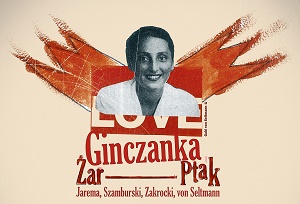 Gabi von Seltmann is an interdisciplinary artist, an animator of culture. Using various art forms, she seeks to answer questions about memory, identity and the implications of history. I would like to talk about musical project „Ginczanka. Fire-Bird“. The inspiration for the creators of the project is the timeless poetry of the Jewish poet Zuzanna Ginczanka. Hence, more than seventy years after her tragic death, the legacy of Ginczanka and her genius are brought to life once more, on the stage.
Gabi von Seltmann is an interdisciplinary artist, an animator of culture. Using various art forms, she seeks to answer questions about memory, identity and the implications of history. I would like to talk about musical project „Ginczanka. Fire-Bird“. The inspiration for the creators of the project is the timeless poetry of the Jewish poet Zuzanna Ginczanka. Hence, more than seventy years after her tragic death, the legacy of Ginczanka and her genius are brought to life once more, on the stage.
Cantor + Woman = Feminist? – Mimi Sheffer (Berlin, Germany)
A workshop discussing experiences, feelings and thoughts of the participants as women acting in a general role. Development of individual opinions and actions is enabled by listening, meditating and discussing.
Mimi Sheffer www.mimisheffer.com
Josefa Metz and Meta Samson: Two ‘New Jewish Women’ in Nazi Germany – Hadassah Stichnothe (Hanover, Germany)
The presentation seeks to explore two contrasting constructions of femininity within Reform Judaism in the 1930s by pointing to the life and work of Josefa Metz (1871-1943) and Meta Samson 1894-1942). In the mid-1930s, both Metz and Samson saw their life and career increasingly threatened by the German Nazi regime. While Josefa Metz had behind her a career of writing bestselling novels and was then in her 60s, Samson was an aspiring journalist for the C.V. Zeitung and a single mother of three. The presentation will highlight the contrasting concepts of Jewish girlhood within the context of German Reform Judaism by a reading of their two children’s novels – Metz’ Eva. Aus einer glücklichen Kindheit (1937) and Samson’s Spatz macht sich (1938). Incidentally, both feature a girl called Eva as a protagonist, thus signifying the prototypical girl-child. However, while Metz’ novel nostalgically describes an idealized innocent protagonist in a Jewish-German bourgeois idyll, Samson’srealistic novel features an assertive and far from flawless protagonist in1930s Berlin. The two novels may be read as a way of literary defiance in the face of adversity but also as expressions of different concepts of girlhood, pedagogy, and Reform Judaism. In their individual ways, Metz and Samson can be seen as representatives of two generations of New Jewish Women who were willing to re-define women’s role in religion and society.
Hadassah Stichnothe studied Comparative and American Literature at Johannes Gutenberg University Mainz. She wrote her doctoral thesis on children’s novels of initiation. One of her research interests is Jewish children’s literature with a special focus on the Weimar Republic.
Potraits and memories of the Jewish community in Serbia: Women then and now – Dragana Stojanovics, Sonja Viličić (Belgrade, Serbia)
Through different techniques of working with traditional Jewish texts, this workshop will engage some very contemporary questions that are, as it is going to be shown, present in the society and individual understanding for quite a long time. Is every woman’s act that can be regarded as highly interventional in the same time also a feminist act? What are the strategies of working with the patriarchal or other social environments that we live in? Should we strive to the dialogue, opening ourselves to listening to the other positions, or should we strive to maintain our own standpoints? Are those two strategies mutually exclusive? Are there other strategies? What about the issue of sisterhood – should we act as individuals or as a community (both regarding to Jewish, women and feminist community)? And what were the examples that women from Tanach give us to think about? These and a lot of other questions relevant to historical and contemporary notions of feminism will be explored through some interactive workshop discussions.
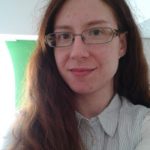 Dragana Stojanović (1983) works in the fields of formal and informal education and publishing, concentrating mostly on the matters of contemporary feminisms, gender studies, culture studies and Jewish studies, exploring it both through working as an Assistant professor in the fields of Theory of art and media and Culture studies at the Faculty of Media and Communications in Belgrade, and also as being active in cultural and educational projects of Jewish community of Belgrade and the organization Haver Serbia. She is especially interested in raising dialogues and discussions related to various intertwinings of tradition and contemporaneity, seeking for a new possible ways of engaging traditional Jewish thought with the contemporary living.
Dragana Stojanović (1983) works in the fields of formal and informal education and publishing, concentrating mostly on the matters of contemporary feminisms, gender studies, culture studies and Jewish studies, exploring it both through working as an Assistant professor in the fields of Theory of art and media and Culture studies at the Faculty of Media and Communications in Belgrade, and also as being active in cultural and educational projects of Jewish community of Belgrade and the organization Haver Serbia. She is especially interested in raising dialogues and discussions related to various intertwinings of tradition and contemporaneity, seeking for a new possible ways of engaging traditional Jewish thought with the contemporary living.
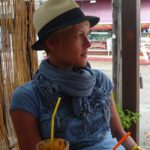 Sonja Viličić was born in Serbia. For almost 10 years Sonja lived in Budapest where she finished University and worked for the J.D.C. (Joint Distribution Committee) in various positions as informal Jewish educator, including the program director of the Szarvas youth camp and the Educational Director of regional programs with the aim of Jewishly educating youth and students through informal educational frameworks. Sonja is a graduate of the Melton Senior Educators Program at the Hebrew University of Jerusalem.Today, Sonja lives in Belgrade, Serbia where she is one of the founders and Executive Director of NGO Haver Srbija whose aim is to introduce non-Jewish population to culture, history and tradition of Jewish people as a step in confronting prejudices, misconceptions and discrimination. She also works co-runs the Matara youth leadership training program of the Rothschild Foundation (Hanadiv) Europe at Limmud UK.
Sonja Viličić was born in Serbia. For almost 10 years Sonja lived in Budapest where she finished University and worked for the J.D.C. (Joint Distribution Committee) in various positions as informal Jewish educator, including the program director of the Szarvas youth camp and the Educational Director of regional programs with the aim of Jewishly educating youth and students through informal educational frameworks. Sonja is a graduate of the Melton Senior Educators Program at the Hebrew University of Jerusalem.Today, Sonja lives in Belgrade, Serbia where she is one of the founders and Executive Director of NGO Haver Srbija whose aim is to introduce non-Jewish population to culture, history and tradition of Jewish people as a step in confronting prejudices, misconceptions and discrimination. She also works co-runs the Matara youth leadership training program of the Rothschild Foundation (Hanadiv) Europe at Limmud UK.
Double Forgotten – Jewish Women Artists from Breslau – Małgorzata Stolarska-Fronia
Increasingly liberal curriculum of the Breslau Art Academy enabled women artists at the beginning of twenty century to become its students. In 1902 they established independent organization – Verband Schlesischer Künstlerinnen. Among them there was a large number of Jewish artists, many of them associated with Breslau avant-garde circles. Since the nineteenth century interest in the arts was nurtured especially in bourgeois Jewish families. In case of Breslau the most characteristic example is Clara Sachs, but it should be noted that young girls from Jewish homes attended private drawing schools such as the one carried by the painter Eugen Spiro.
Jewish women not only in the same time, as Christian women, began to cultivate the liberal profession of artists, but their work was closely linked to the new role and activity that Jewish women have adopted in Breslau. They had their own organizations, of which the most important was the Breslau branch of Jüdischer Frauenbund (1907) led by Paula Ollendorf. Jewish women artists were associated with this milieu, i.e. Käthe Ephraim Marcus, who was the author of expressive portrait of the Frauenbund leader. Among prominent local artists were also Paul Grünfeld and Sara Margot Abraham. Still, little is known about their work. Their status as women – artists, all the more Jewish women – artists, active in the difficult 1930s, sentenced them and their work to oblivion, and their output has been dispersed or destroyed. Based on the notes in catalogs, articles and few works that survived, I would like to restore their significant work to memory.
Małgorzata Stolarska-Fronia, Ph.D, art historian, curator, translator, academic teacher. Associate professor at the Nicolaus Copernicus University in Toruń (Poland); former Head of the Scientific Department at the Museum of the History of Polish Jews in Warsaw; involved in designing the core exhibition as a curator of the 17th c. gallery. Author of the book “Participation of Breslau Jews in the artistic and cultural life of the city from the emancipation until 1933” (Warsaw 2009) and several articles devoted to the issue of modern art in the Jewish culture. Organizier of the Congress of Jewish Art in Poland (2008, 2013). Studied at the University of Wroclaw (Poland), Philipps-Universität Marburg (Germany), European Institute of Jewish Studies PAIDEIA (Sweden), University of Sussex (UK). Awarded by the National Science Centre in Poland a three-year research grant, is currently implementing a project “Jewish Expressionism – a quest for cultural space”.
Master Class: open klezmer music workshop – Alicia Svigals (USA)
Please reserve your spot at alternatives@fbk.org.pl
Composer/musician Alicia Svigals is the world’s leading klezmer violinist and a founder of the Grammy-winning Klezmatics, which she co-directed for seventeen years. She has written for violinist Itzhak Perlman, the Kronos Quartet, playwright Tony Kushner, documentary filmmaker Judith Helfand, singer/songerwriters Debbie Friedman, Diane Birch et al, and has collaborated with them as a performer and improviser as well as with poet Allen Ginsburg, Robert Plant and Jimmy Page of Led Zeppelin, Gary Lucas and Najma Akhtar, and many others. She has appeared on David Letterman, MTV, Good Morning America, PBS’ Great Performances, on NPR’s Prairie Home Companion, Weekend Edition and New Sounds, and on the soundtrack for the L-Word.
“Bye, bye, Cancer! Welcome, Life!” How a life threatening diagnosis helped me to become a better Jew and a stronger feminist – Gunda Trepp (San Francisco, Berlin)
It was July 2015, Berlin. I went home from Charité, riding my bike, and, while crossing the beautiful Tiergarten, had just one thought: “Now it finally has hit me.” I had just been diagnosed with a triple negative carcinoma in my right breast, and within a couple of days I knew most you have to know about it. Not so good. A lot of women don’t even make the crucial five years after surgery.
We carry the BRCA-gen mutation on my mother’s side. My grandmother, my mother, my aunts, most of my cousins either carry the mutation or have already been fighting breast- or ovarian cancer, quite some of them losing the fight in young age. Well, I was 56, not so young anymore, but still: was I ready to go?
A journey began. I would like to share what I have learned while walking down this road. These are some of the thoughts:
I would like to talk about how much I loved life and to being alive during this time. There was no bitterness, only gratitude. Judaism helped me a lot to respond this way. I would like to talk about the question how we as Jewish women can transform our love for life into a different form if living. Is that even possible?
I could never comprehend the meaning of being created in G’d’s image in a more profound way. I found a new way to look at myself. Today I see myself as a mind and an intellect that both need the body. I do appreciate my body, but not as a showoff anymore as women do far too often, but as something to take better care of and to appreciate as something miraculous and wonderful.
And I would like to share some advice:
Be informed. A lot of gynecologists are not.
Get tested for the mutation if you have reasons although you don’t have and do not want to have children. You still need to know. I didn’t and I was on birth control pill and still had my ovaries although it is proven that their removal not only decreases the risk of getting ovarian cancer to almost zero, but also reduces the risk of breast cancer.
Get a better sense of your body. Let not men define who you are and how you feel about yourself. You need new breasts? Great. They stand for survival. If a guy doesn’t get that, leave the guy and embrace your new You.
And there is nobody who understands your body better than you. Listen!!I should have listened. In the very beginning I didn’t feel this was right. My family members had gotten cancer much earlier. But when all Professors tell you, it’s true, well, then it must be true. The irony is that in the end it turned out that my feeling had been right. Charité had messed me up. It was a terrible misdiagnosis.
Am I angry? Yes. I had so many painful procedures and have scars for no reason. They put my brothers and friends through anxiety and pain for nothing. I lost bushes and bushes of my hair and harmed my immune system severely – for nothing.
But I am so gratefultoo – for new insights into life and the end of life and, mostly, for life itself.
Gunda Trepp is a trained attorney and journalist. As an attorney, her specialization was business law, which she practiced in Germany. As a journalist, she has written for major German publications and broadcast on a variety of topics including economics, politics, cultural affairs and, most personally, issues facing the Jewish world. She just completed her first novel and is currently working on an essay about today’s role of Jews in Germany as well as on the biography of her late husband, Rabbi Leo Trepp. She has lectured on the consequences of the Shoah and the rise of new anti-Semitism in Germany as well as in the United States. Gunda resides in San Francisco and Berlin.
Personal Affects – Going into the Archive – Tanya Ury (Cologne, Germany)
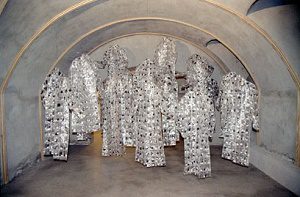 With the destruction of the Cologne Archive, a thousand years of German history was projected into the rain and mud; but it also included the legacy of my Jewish family that had previously already been marked by exclusion, during the Nazi regime – for in spite of having lived through persecution and exile, my family had been fortunate enough to possess archived material, over and above our aural history.
With the destruction of the Cologne Archive, a thousand years of German history was projected into the rain and mud; but it also included the legacy of my Jewish family that had previously already been marked by exclusion, during the Nazi regime – for in spite of having lived through persecution and exile, my family had been fortunate enough to possess archived material, over and above our aural history.
Eberhard Illner, who until 2008 had been responsible for the departments Collections, Photography and Estates at the Historical Archives in Cologne, had expressed an interest in collecting our legacy because my British-German-Jewish family had been culturally active in Germany before and after the Second World War. I quote Illner, who since 2008 has been the Director of the Historical Centre in Wuppertal, speaking about our legacy in a German radio interview broadcast in January 2015: “You have to be aware that in Germany, not much has survived from this era, so that the deceased, suppressed cultural life in Germany was, or is actually only reconstructable by those creative artists in exile, who have emigrated – you will only find authentic material there.”
Personal Affects – Going into the Archive is a paper about some of my art and written work but in particular about the history of the bequest that my siblings and I entrusted to the Archive in 1998, following the death of our mother in London.
Tanya Ury
1951* London (GB)
1993 English/German (dual) nationality & moved to Cologne (D)
1971 Foundation in Fine Art, Central School of Art and Design, London (GB)
1988 BA HONS in Fine Art, First Class, Exeter College of Art and Design (GB)
1989 1 semester, Institute for Theatre, Film and Television Studies, Cologne University with Erasmus grant (D)
1990 Masters in Fine Art, Distinction, Reading University (GB)
2010 PhD. in Humanities candidate, with Prof. Ernst J. van Alphen, Faculty of the Humanities, Leiden University Institute for Cultural Disciplines (LUICD) (NL)
2014 From 2014, jury member for the Hans and Lea Grundig Prize, with the Rosa Luxemburg Foundation, Berlin (D)
As a writer, activist, and in her photography, installations, performance, video art, poems and improvised poetry, Tanya Ury deals with questions of Judeo-German identity, the handling of German society with its history, the role of the subaltern women against the background of migration and racism. Ury has been living and working in Cologne, Germany, since 1993. Most of her family lived here before being murdered or having to flee into exile because of their Jewish origins.
Female Face of the “Jewish Revival in Poland”: Biographies of Polish-born Jewish Activists in Newly Democratic Poland after 1988 – Aleksandra Wilczura (Wroclaw, Poland)
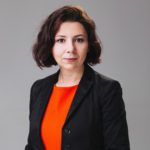 Aleksandra Wilczura was born and lives in Wroclaw, Poland. She is the President of Cukunft Jewish Association and Hasmonea Jewish Sports Club, a member of Wroclaw’s Jewish community and Socio-Cultural Association of Jews (TSKZ). Sometimes she acts as an educator and mashgcha kashrut of events for the Jewish community in Vilnius, Lithuania. As a young Jewish leader, she was a regional representative for the Polish Union of Jewish Students in Krakow (2001-2005) and Wroclaw (2004-2005). Later, she co-established Czulent Jewish Association in Krakow (2005), HAMSA (2006), the first Zionist youth organization in Poland since 1968 and, Cukunft Jewish Association (2014). In 2006 Aleksandra was appointed the Director of the Jewish Agency for Poland and Kalliningrad District. After finishing her MA in Jewish Studies and MA in Middle and Far East Studies at the Jagiellonian University in Krakow, she continued her studies in Oxford and Jerusalem. Currently, she leads the “The Middle East Studies”magazine (Studia Bliskowschodnie) and specializes in religions and cultures of the Middle East, especially Turkey, Israel and Iran.
Aleksandra Wilczura was born and lives in Wroclaw, Poland. She is the President of Cukunft Jewish Association and Hasmonea Jewish Sports Club, a member of Wroclaw’s Jewish community and Socio-Cultural Association of Jews (TSKZ). Sometimes she acts as an educator and mashgcha kashrut of events for the Jewish community in Vilnius, Lithuania. As a young Jewish leader, she was a regional representative for the Polish Union of Jewish Students in Krakow (2001-2005) and Wroclaw (2004-2005). Later, she co-established Czulent Jewish Association in Krakow (2005), HAMSA (2006), the first Zionist youth organization in Poland since 1968 and, Cukunft Jewish Association (2014). In 2006 Aleksandra was appointed the Director of the Jewish Agency for Poland and Kalliningrad District. After finishing her MA in Jewish Studies and MA in Middle and Far East Studies at the Jagiellonian University in Krakow, she continued her studies in Oxford and Jerusalem. Currently, she leads the “The Middle East Studies”magazine (Studia Bliskowschodnie) and specializes in religions and cultures of the Middle East, especially Turkey, Israel and Iran.
Rosa Luxemburg Behind Bars in Breslau: a collage reading – Sandi Wisenberg (Chicago, USA)
Revolutionary, theorist, economist, author, philosopher Rosa Luxemburg was born into a Jewish family in Zamosc in 1871, raised in Warsaw; she studied in Zurich (PhD, Poland’s industrialization, 1897), and was murdered in Berlin in 1919. She was imprisoned for her anti-war activities, during the War to End All Wars. She had made her views known that European working men should not be fighting against one another on a mass level. I propose a presentation that begins with a biographical and political overview, concentrating on her anti-war writings, as this is the centenary of that war. I will also read from her blissful letters to Sophie Liebknecht– about the sky and birds and plants and literature–from Breslau Prison 1917-1919, and put them in context by juxtaposing them with writings by others during that time (such as Emma Goldman, and Gandhi—who led his first successful peaceful campaign in 1917).
S.L. (Sandi) Wisenberg has participated in the London, Vienna and Sofia Bet Debora conferences. She is named for her grandfather Solomon Louis Wisenberg/Waysenberg, who immigrated to the US about 100 years ago from Kishinev, Moldavia/Moldova. Three of her grandparents were born in Eastern Europe, and they and her parents lived mostly in the American South. She was born in 1955 and grew up in Texas. She’s the author of a book of short stories, The Sweetheart Is In; a book of essays, Holocaust Girls: History, Memory & Other Obsessions; a personal/political chronicle, The Adventures of Holocaust Girls; and a creative nonfiction book of verbal collage, Moments in Selma & Other Glimpses of the South (with more Jews than you would think), forthcoming in 2015 from the University of Georgia Press. She lives in Chicago. She had a bachelor’s in journalism from Northwestern University and a Master of Fine Arts in fiction writing from the University of Iowa.
The Jewish Romanian Women: Post Communism/Revolution Times – Peninah Zilberman (Canada/Israel/Romania)
The Jewish women in Romania post communism era either a survivor, second generation or following generations were definitely affected by the years they grew up during the Communist era, and how they practice Jewish Life Cycles events today. Generally speaking the Romanian Jewish Community contrary to other Jewish Communities in Eastern Europe was never considered religious but an assimilated Community. Romania is divided by Regions which correspond to the level of Jewishness in the families.
The most religious Jews were in Northern Transylvania- Sighet- Maramures Region with cities e. g. Satu Mare, Cluj, Margita, Sighet etc. Due to the 1944 deportations of that Community very few returned as most of them found their fate in Auschwitz. Females who survived the holocaust, had well and quite clear memories of their Jewish homes Life Cycle; however the younger the person was when they were deported the less they could remember. Everyone wanted to start a new life- which meant marry and have children- but cannot openly handle a Jewish Home.
In my presentation I will demonstrate through examples of women who fall in all above categories how they manage their Jewish Homes and Life – Today. I had/have the opportunity to meet some of these women. They have given me their permission as well as taking their pictures, which I will show during my presentation. Today’s Jewish Women in their 35+ are very much eager to learn and practice Judaism in their homes and transmit the Jewish Heritage to their children even if they are married to non-Jewish man.
Peninah Zilberman was born in Israel to survivor parents from Sighet – Transylvania and Bucharest – in Romania. Peninah served the Toronto Jewish Community for over 40 years in various capacities as a Hebrew teacher at Day Schools, Principal of Hebrew Schools and the Director of the Holocaust Museum. Ms. Zilberman initiated the “70th Anniversary to the Sighet Jewish Deportations” in cooperation with the Sighet Municipality – an international four day event May 17-20, 2014, followed by the “Intergenerational Gathering May 14-18, 2015.
In 2008 Ms. Zilberman initiated and produced the Israeli Opera “and the Rat Laughed”, by author Nava Semel and libretto by Ella Milch –Shariff. North American premiere in the Hebrew Language as part of IsrCan Productions – Cameri National Theatre. In 2006 Peninah was guest speaker at the Bucharest & Cluj Universities presenting at the Holocaust Annual Teachers’ Seminar: “Challenges and Objectives when Teaching the Holocaust: Four Generations After”. In 2000 Peninah presented a paper at the International Holocaust Conference in Oxford, England, on the topic of “Genocide, Trauma and Refugees: A Guide for Second Generation Empowerment and Change”.
Ms. Zilberman initiated Intergenerational Heritage Journeys to Poland starting in the early 1990’s following the lifting of the Eastern European Block. In addition she continued to explore other famous Jewish Centers like Prague, Vienna and Budapest following by her own search of roots in Romania. Peninah enjoys leading groups through Eastern Europe providing the traveller with a unique experience including culture, religion and nature.
Ms. Zilberman is a Jewish and Holocaust Education consultant for theatre directors, playwrights, musicians and artists. The research for the Holocaust series by the Canadian author Carol Matas were prepared by her. Ms. Zilberman is facilitating Genealogical research for individuals when creating their family trees.
Presently Peninah shares her time between Canada, Romania and Israel. In 2014 Peninah established the “Fundatia Tarbut Sighet- Cultura si Educatie Iudaica” – Tarbut Foundation- Culture and Judaica Education”, educational and cultural events are planned for 2016. Peninah has been blessed with three children and four grandchildren, who are always involved in servicing their Communities in Canada and Israel.
Series of paintings – collages about Jewish women artists from Poland – Zuza Ziółkowska Hercberg
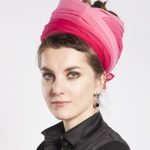 Zuza Ziółkowska / Hercberg is a painter, author of installations and performative actions. Her recent works are developed on the basis of artist’s own method with use of mixed painting techniques, characterize themselves by organic forms, rich texture and intense color. The artist is interested in subject of memory and body, as well as issues related to a broad sense of identity and belonging to a place. Currently she is working on her PhD at the Warsaw Academy of Fine Arts at the Media Art Department in Studio of Painting Space of Professor Leon Tarasewicz and Assistant Professor Pawel Susid, and in Studio of Art of the Public Domain run by Professor Krzysztof Wodiczko.
Zuza Ziółkowska / Hercberg is a painter, author of installations and performative actions. Her recent works are developed on the basis of artist’s own method with use of mixed painting techniques, characterize themselves by organic forms, rich texture and intense color. The artist is interested in subject of memory and body, as well as issues related to a broad sense of identity and belonging to a place. Currently she is working on her PhD at the Warsaw Academy of Fine Arts at the Media Art Department in Studio of Painting Space of Professor Leon Tarasewicz and Assistant Professor Pawel Susid, and in Studio of Art of the Public Domain run by Professor Krzysztof Wodiczko.
She has participated in numerous exhibitions such as: DABROWSZCZACY – DISAVOWED AMONG DISAVOWED, art action, Tomb of the Unknown Soldier in Warsaw (2016); The 42nd Painting Biennale Bielska Jesień 2015, Bielska BWA Gallery, Bielsko – Biała (2015); Czech-Polish Stars, Kubik Gallery, Litomysl, Czech Republic (2015); Order out of Chaos, Le Guern Gallery, Warsaw (2015); Colors for the planet, headquarter UNESCO, Paris, France (2015); Proposed period of time, Corridor Gallery, Użhorod, Ukraine (2014); Progress and Hygiene, Zachęta – National Galery of Art, Warsaw (2014); שטילקייט, Próżna Street 14, Warsaw (solo exhibition during 11th Singer Festival of Jewish Culture in Warsaw, (2014); Jude, Татары,….site-specific project , Spokojna 15, Warsaw (2014); Strażnicy Szabatu, Schomre Schabos, Stražci Šábesu, site-specific project, building of an old synagogue, Cieszyn, Czech Republic (2014); Everywhere is everywhere, solo exhibition, Gallery Biała, Lublin (2013); AAAcupuncture, Kordegarda Gallery, Warsaw (2012); COMING OuT-Best 2011 Graduates of the Academy of Fine Arts in Warsaw, exhibition and site-specific project in building of Sinfonia Varsovia,Warsaw (2011).
Mentoring – Mariann Ziss (Prague, Czechia)
Our professional experience, knowledge and network is our main capital. By passing it on we can build new alliances and provide younger women with a unique opportunity. Building on Jewish values this workshop shows you the most important skills you can learn to mentor people you choose to support in a professional way.
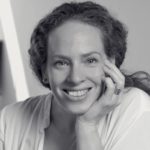 Mariann Ziss is a psychotherapist and a coach. She is from Budapest, lives in Prague for 10 years. As a consultant she works in diversity management, focusing on gender, age and cross-cultural diversity. Her research field is women in life transitions, where she is building on her observations that come both from psychotherapy and consulting. She supports local Jewish youth programs and the Lauder School.
Mariann Ziss is a psychotherapist and a coach. She is from Budapest, lives in Prague for 10 years. As a consultant she works in diversity management, focusing on gender, age and cross-cultural diversity. Her research field is women in life transitions, where she is building on her observations that come both from psychotherapy and consulting. She supports local Jewish youth programs and the Lauder School.
With support from Leatid![]()


